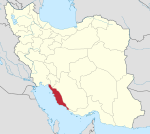Angali Rural District
Angali Rural District
Persian: دهستان انگالي | |
|---|---|
| Coordinates: 29°11′28″N 50°47′51″E / 29.19111°N 50.79750°E[1] | |
| Country | Iran |
| Province | Bushehr |
| County | Bushehr |
| District | Central |
| Capital | Koreh Band |
| Population (2016)[2] | |
| • Total | 2,209 |
| Time zone | UTC+3:30 (IRST) |
Angali Rural District (Persian: دهستان انگالي)[3] is in the Central District of Bushehr County, Bushehr province, Iran.[4] Its capital is the village of Koreh Band.[5]
At the census of 2006, its population was 2,636 in 557 households.[6] There were 2,301 inhabitants in 601 households at the following census of 2011.[7] In the most recent census of 2016, the population of the rural district was 2,209 in 653 households. The most populous of its 25 villages was Koreh Band, with 1,203 people.[2]
Background[edit]
This section needs additional citations for verification. (November 2023) |
The district is located near the coast of the Persian Gulf, some fifty-five kilometers to the north of the city of Būshehr, the capital city of the Būshehr province, at the southwest of Iran. It is enclosed between the Rūhelle River (= local for rūd helle, "Hellé River") and the Shabānkāre district on the north, the Rūhelle district on the west, the Būshehr harbor on the south, and the Dashtestān District to the east.
At one time it was under the jurisdiction of the governor of the Persian Gulf Ports. In conjunction with Būshehr, this province was later developed into the province of “Būshehr and Banāder” (‘Bushehr and the ports’). Angāli was formerly a part of the Dashtestān province and later it was separated for administrative purposes. Although historically Angāli has always been one of the important and strategic centers of political activity (partly due to the conflict between the local khāns [‘chieftains’] and the central government, over matters such as independence and fire arms control, etc.), Angāli was never registered on maps of Iran. Even in the most current maps only occasionally it is included. One of the main reasons is rooted in the strategy of the Pahlavi regime (under Reza Shah, as well as his son and successor Mohammad-Reza, a.k.a. the Shah) who kept the regional powers (that is, the khāns, kalāntars, and their tribes and tribesmen) in low profile, in order to prevent any possible encouragement for others, who might follow their foot steps in dealing with the central government. In fact, Lorimer attests that, “the men of Angāli are described as brave and hard working.”[8] It is not infrequent in the history of Iran that the central governments fear these “brave and hard working” local men.
Religion[edit]
This section needs additional citations for verification. (November 2023) |
Angāli people are Shi’ite Muslims, believing in the twelve Imams. They are faithful believers, and, except for children and some of the youth before the legal age of eighteen, they all observe their religious rituals——three times of prayers during the day, annual fasting, etc.
References[edit]
- ^ OpenStreetMap contributors (30 March 2023). "Angali Rural District (Bushehr County)" (Map). OpenStreetMap. Retrieved 30 March 2023.
- ^ a b "Census of the Islamic Republic of Iran, 1395 (2016)". AMAR (in Persian). The Statistical Center of Iran. p. 18. Archived from the original (Excel) on 3 August 2017. Retrieved 19 December 2022.
- ^ See Angali, Koorosh, The Angāli Dialect, dissertation, UC Berkeley, CA, 2004.
- ^ Habibi, Hassan (7 July 1369). "Approval of the organization and chain of citizenship of elements and units of country divisions of Bushehr province centered on Bushehr city". Lamtakam (in Persian). Ministry of Interior, Political Defense Commission of the Government Board. Archived from the original on 24 April 2024. Retrieved 24 April 2024.
- ^ Mousavi, Mirhossein (18 August 1365). "Creation and formation of two rural districts including villages, farms and places in Bushehr County under Bushehr province". Lamtakam (in Persian). Ministry of Interior, Council of Ministers. Archived from the original on 1 December 2023. Retrieved 1 December 2023.
- ^ "Census of the Islamic Republic of Iran, 1385 (2006)". AMAR (in Persian). The Statistical Center of Iran. p. 18. Archived from the original (Excel) on 20 September 2011. Retrieved 25 September 2022.
- ^ "Census of the Islamic Republic of Iran, 1390 (2011)". Syracuse University (in Persian). The Statistical Center of Iran. p. 18. Archived from the original (Excel) on 3 April 2023. Retrieved 19 December 2022.
- ^ Lorimer, John Gordon. The Gazetteer of the Persian Gulf, Oman and Central Arabia. Calcutta: Superintendent Government Printing, India, 1908.


